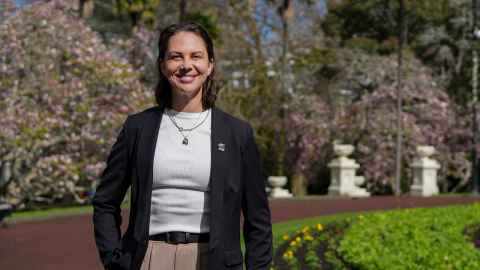Active bystanders crucial to safer public transport
22 August 2024
Fostering a culture of active bystanders could help women and other vulnerable groups feel safe using public transport, according to new research.

Encouraging people to become ‘active bystanders’ could be key to making women and vulnerable groups feel confident to use public transport, a new University of Auckland study finds.
For many women and people with intersectional identities, including gender diversity, ethnicity and disability, the presence of supportive bystanders is a critical factor in their decision to use public transport, according to the study.
“No one deserves to be harassed, and that includes people whose identities fall outside societal norms,” says Kirsten Tilleman, a doctoral candidate in the Faculty of Engineering who led the study.
“We also need increased uptake of public transport to support a more sustainable transportation future.
“Feeling unsafe taking public transport is a barrier for many people. And for those without a choice, both the fear and experience of harassment and other forms of violence should not have to be endured.”
An active bystander is someone who notices a problematic or harmful situation, such as harassment, and chooses to take action to prevent or intervene in a safe and constructive way. This can involve offering support to the person targeted, seeking help from others, or confronting the offender. Supportive bystanders on public transport can include other riders and public transport staff, such as bus operators.
The study, which involved an online survey of 524 participants in Auckland closely presenting the gender make-up of the general population, built on earlier research finding women are more likely to avoid public transport for fear of harassment.
The new research looked at how women’s expectations of bystanders influence their transport decisions.
It delved into how community support, social norms, perceived responsibilities of authorities and environmental factors shape women’s perceptions of security and therefore decisions about public transport.
It doesn’t require a huge act to make a meaningful difference. Bystanders who visibly support marginalised groups can play a crucial role in preventing and responding to inappropriate and violent behaviours.
The study also explored the role of men as bystanders, revealing that many men and a subset of women feel confident in their ability to help in harassment situations.
Tilleman says this suggests there is potential for encouraging more men to learn how to effectively de-escalate situations and step into the role of active bystanders, making public transport safer for everyone.
“It doesn’t require a huge act to make a meaningful difference.
“Bystanders who visibly support marginalised groups can play a crucial role in preventing and responding to inappropriate and violent behaviours.
“Women and other marginalised groups can take some comfort in knowing there are people around who might deter and de-escalate harassment and other forms of violence.”
A common misconception of being an active bystander is that the only option is to directly confront the perpetrator, adds Tilleman.
“I’d argue that direct confrontation should be considered last because it risks redirecting the violence to the bystander and escalating the situation. There are multiple ways to be an active bystander that are less risky.
“I really like the 5 Ds of Bystander Intervention from Right to Be. The first four “Ds” are all indirect: Distract (indirect approach to de-escalate), Delegate (getting help), Document (documenting the incident) and Delay (check in with the person who was harassed). Only the fifth “D” is Direct (speaking up about the harassment).”
In 2023, Transport for London launched a campaign aimed at encouraging active bystander participation on its services.
Tilleman says bystander programmes that involve public transport staff and riders can be a powerful tool for public transport providers, particularly those with limited resources.
“I understand the challenges faced by public transport providers, having worked with them for ten years before starting my PhD. The reality is they have to make tough trade-offs about where they invest their limited resources. Our study suggests that active bystander programmes are worth it, at least if they’re developed and implemented effectively and in partnership with community organisations that reflect ridership diversity.”
It's also important that not all active bystander strategies are the same, says Tilleman.
“It’s crucial that people with marginalised identities, like the transgender community, see themselves reflected in anti-harassment communication materials. Riders need to know that they are included in the protections of anti-harassment programmes, and that there is no fine print listing their identities as an exception to receiving support in an incident of harassment or other form of violence.
“Every day we’re bombarded with messages that ‘other’ and dehumanise people, which can desensitise us to violence and affect how we interact with each other. However, if we choose to be attentive, we can offer each other a bounty of compassion, care and belief, and help create a more just and caring world.”
Media contact
Hussein Moses | Media adviser
M: 027 361 1000
E: hussein.moses@auckland.ac.nz